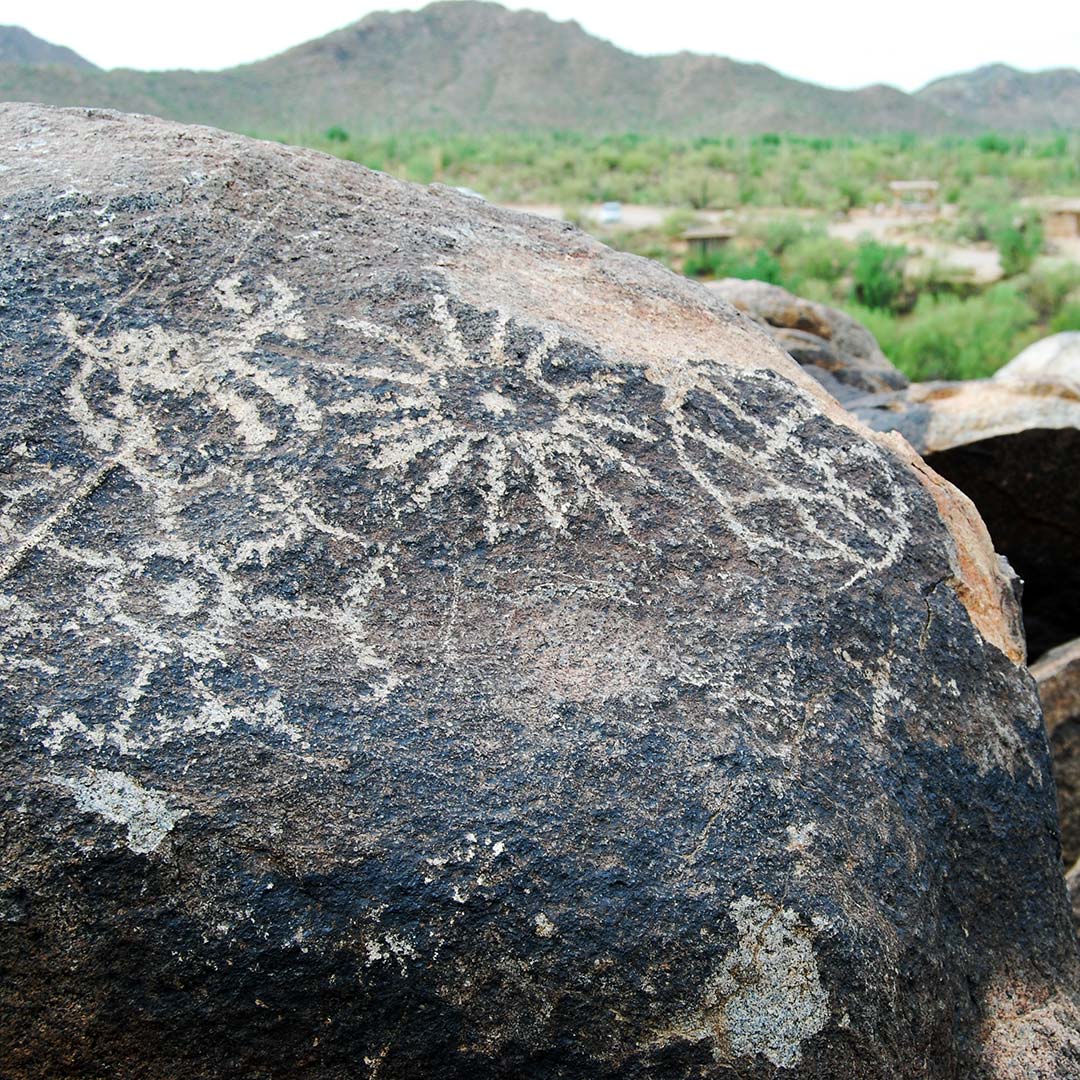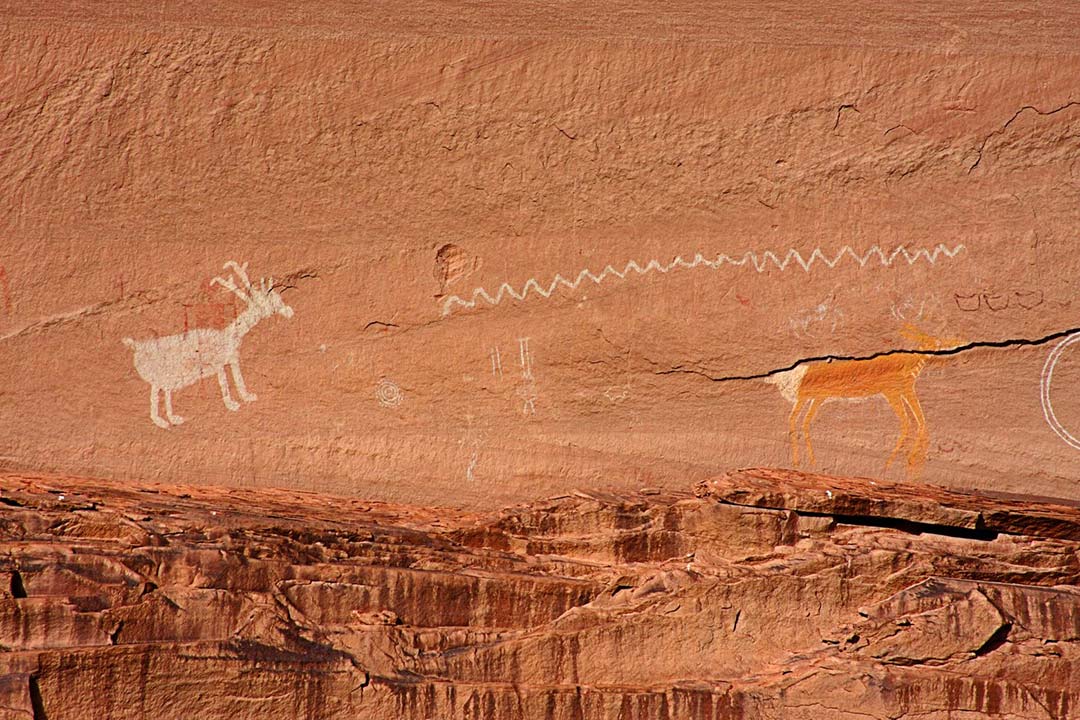The Best Places to See Rock Art in Arizona
From black-rock deserts to red-rock canyonlands, Arizona is a vast and sunny gallery of ancient art. For thousands of years the people of this hard and varied land scratched mysterious images on naturally varnished boulders and rock faces, and pecked their dreams and mythologies into soft sandstone cliffs; these are called petroglyphs. Others mixed long-lasting pigments from plants and minerals to paint handprints, footprints, animals and gods on the walls of shallow sheltering caves in high canyon walls; these are called pictographs.
Today these images still speak to us, though we’ll never know exactly what they were meant to say.
My favorite of Arizona’s petroglyphs is a stylized mountain lion that an unknown Ancestral Puebloan artist scratched into a large slab of rock some 600 to 1000 years ago. Discovered in the Blue Mesa area of Petrified Forest National Park in 1934, this American masterpiece is now on display at the park’s Painted Desert Inn Visitor Center. I wonder what the artist would think of the fact that their work, all these centuries later, is reproduced on so many baseball caps, postcards and magnets sold at the park’s gift shop?

Sometimes I think about the success of this unknown artist when I put on my own cap with the orange-thread re-creation of the mountain lion petroglyph, one I bought a few years ago during a visit to Petrified Forest to stay safe from the angry Arizona sun. Why did I choose this one? Why does this pecked-in stone picture continue to charm me to the point that I wear it daily? These are questions that get to the meaning of rock art in general.
To me, rock art is art in the fundamental sense. Whether it’s the religious imagery of the Middle Ages or the disturbing modern isolation of British painter Francis Bacon’s howling freaks, on some level all art attempts to reignite the sacred embers of our prehistory, to bring us back to a world where we were tied, to a depth that today we can never truly understand, to the cosmic rhythms and self-evident magic of the natural world.
Rock art is a physical reminder of a time where fertility rituals and sympathetic magic actually worked, where shamans and the gods they served walked the same trails and routes, where myths were truth. People seek out petroglyphs and pictographs because of a fascination with those people and their beliefs, and maybe as a way to honor them too.
To explore the many meanings of rock art, to us, to the artist, and to a long-gone audience, here are the best places to go in Arizona.
Newsletter Signup
By clicking ‘Sign Up,’ I acknowledge that I have read and agree to Hachette Book Group’s Privacy Policy and Terms of Use
Petrified Forest National Park
Along with the above-mentioned mountain lion, there are many fascinating and mysterious petroglyphs at Puerco Pueblo and Newspaper Rock. Both are stops along the main road through the park.
Crane Petroglyph Heritage Site
About 20 miles from Sedona in central Arizona’s lush Verde Valley, this site preserves hundreds of petroglyphs made by the Southern Sinagua people from about AD 1150-AD 1400 (Fri., Sat., Sun. Mon., 9:30 am -3 pm; 2.8 miles east of I-17 and SR 179 on FR 618, just past the Beaver Creek Campground).
Saguaro National Park West

Head west out of Tucson over dramatic Gates Pass to the park’s Tucson Mountain District, about 25 miles from downtown. Along the Signal Hill Trail you’ll see 800-year-old petroglyphs made by the Hohokam people, who once farmed the desert river valleys around Tucson and Phoenix. The trail starts at the Signal Hill Picnic Area.
Navajo Nation and Hopi

The sprawling Navajo Nation in northeastern Arizona is full of the ruins and rock art of the ancient Ancestral Puebloans. You must hire a Navajo guide to see most of them. Canyon De Chelly National Monument is a must-visit for rock-art seekers–it’s one of the few sites in the state where you can see pictographs along with petroglyphs. For a list of guides go to www.nps.gov/cach.
The Hopi people live in villages on top of three mesas alongside the Navajo Nation in northeastern Arizona. They are the descendants of those who left behind many of the best-preserved ruins and much of the rock art in Arizona, and who lived, developed and thrived throughout the Southwest for thousands of years. For about $145 per person a Hopi guide will take you to Taawaki/Dawa Park, an imposing, 200-foot high rock ridge with thousands of petroglyphs dating from 200 BCE to AD 1300. Check out https://experiencehopi.com/tours/ to find a guide and plan a once-in-lifetime trip.
Vast open spaces, dreamy canyons, and colorful culture: experience it all with Moon Arizona & the Grand Canyon.
Newsletter Signup
By clicking ‘Sign Up,’ I acknowledge that I have read and agree to Hachette Book Group’s Privacy Policy and Terms of Use
Pin It for Later


